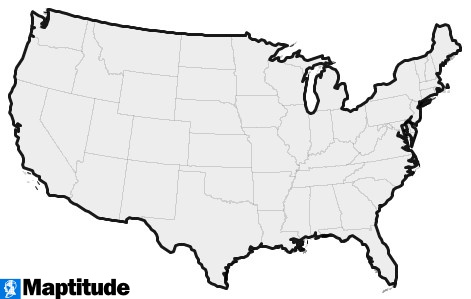Mapping Software and GIS Glossary
A Sales territory hierarchy is a structured system of organizing sales territories, typically reflecting the managerial corporate hierarchy. This system is designed to ensure that every potential customer within a specific geographical area is accounted for and that responsibilities are clearly delineated.

A sales territory hierarchy map of balanced territories, areas, and regions
At the top of the hierarchy, you might have a National Sales Manager who oversees all sales activities across the country. This level is responsible for setting overall sales goals, developing national sales strategies, and coordinating with regional managers.

The next level down could be Regional Sales Managers. They are responsible for a specific region, such as the Northeast or Southwest. Their role involves setting sales targets for their region, managing the sales team within that region, and implementing the national sales strategies at a regional level.

Beneath them, you might find Area Sales Managers. These managers oversee sales activities in a smaller area, perhaps a single state or a part of a large state. They coordinate with the sales representatives, set area-level goals, and ensure that the sales strategies align with both regional and national objectives.

Finally, at the bottom of the hierarchy, you have the Sales Representatives. These are the individuals who are out in the field, meeting with customers, and making the sales. They are responsible for managing relationships with specific accounts within their assigned territories.

Each level in this hierarchy has its own set of responsibilities and goals, but all work together towards the company's overall sales objectives. By structuring sales territories in this way, companies can ensure efficient use of resources, clear communication, and effective implementation of sales strategies. It's a system that promotes accountability, enhances collaboration, and ultimately drives sales success.
Sales territory hierarchies are a crucial component of effective sales territory management. They provide a structured approach to organizing and managing sales territories, enabling better oversight, resource allocation, and performance tracking. Here are some key reasons why sales territory hierarchies are important:
Sales territory hierarchies allow for a clear delineation of responsibilities and reporting structures. By organizing territories into hierarchical levels (e.g., regions, districts, and individual territories), sales managers can more easily oversee and manage their teams. This hierarchical structure facilitates better communication, goal setting, and performance evaluation across different levels of the sales organization.
Territory hierarchies help sales organizations allocate resources more effectively. By analyzing data at different hierarchical levels, sales leaders can identify areas that require additional support or resources. This could involve reallocating sales representatives, adjusting quotas, or providing targeted training and coaching to specific teams or regions.
With a hierarchical structure in place, sales organizations can track and analyze performance metrics at various levels. This allows for more granular insights into the performance of individual sales representatives, teams, districts, and regions. Sales leaders can identify top-performing and underperforming areas, enabling them to replicate successful strategies or address challenges more effectively.
Sales territory hierarchies facilitate better alignment of territories with market dynamics, customer needs, and organizational goals. By analyzing data at different hierarchical levels, sales operations teams can identify opportunities for territory realignment, ensuring that sales resources are optimally distributed and aligned with market potential.
As sales organizations grow and expand into new markets or regions, sales territory hierarchies provide a scalable framework for managing and organizing territories. New territories can be easily integrated into the existing hierarchy, allowing for seamless expansion while maintaining oversight and control.
Maptitude, a powerful sales territory mapping software and GIS, is an invaluable tool for effectively managing hierarchies. It provides a comprehensive suite of tools and data specifically designed for creating, visualizing, and analyzing hierarchical sales territories at any level. Maptitude provides a visual representation of the territories, making it easier to understand the structure and distribution of accounts across different regions. This visual clarity can lead to more strategic decision-making and resource allocation. Furthermore, Maptitude has collaborative features that allow for real-time updates and sharing of information across different levels of the hierarchy, promoting effective communication and teamwork. Maptitude not only helps in mapping the sales territory hierarchy but also enhances the overall efficiency and productivity of the sales team.
With Maptitude, sales organizations can optimize their territory structures, balance workloads, track performance, and make data-driven decisions to drive revenue growth and operational efficiency.

Home | Products | Contact | Secure Store